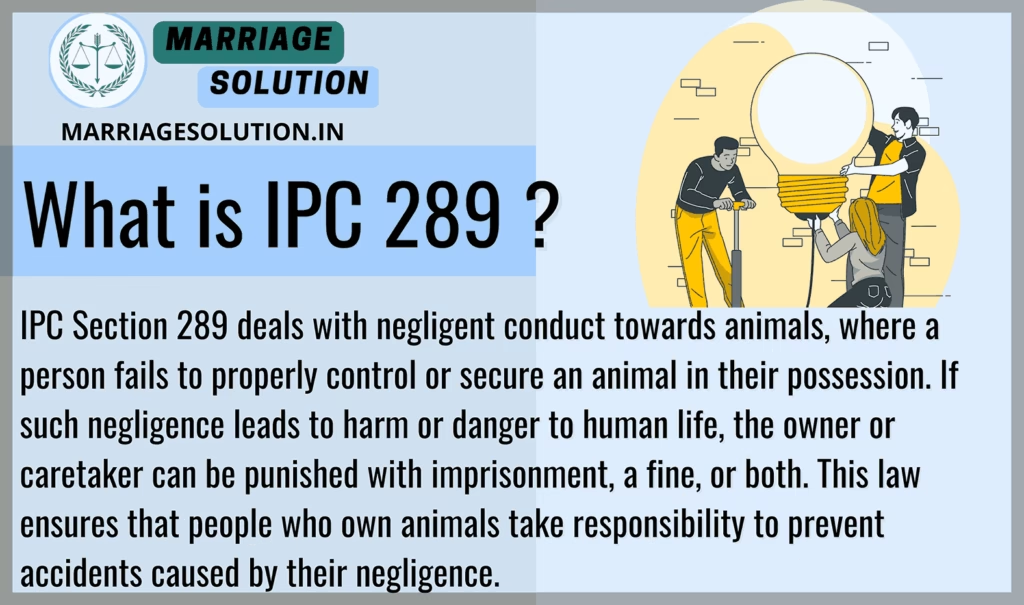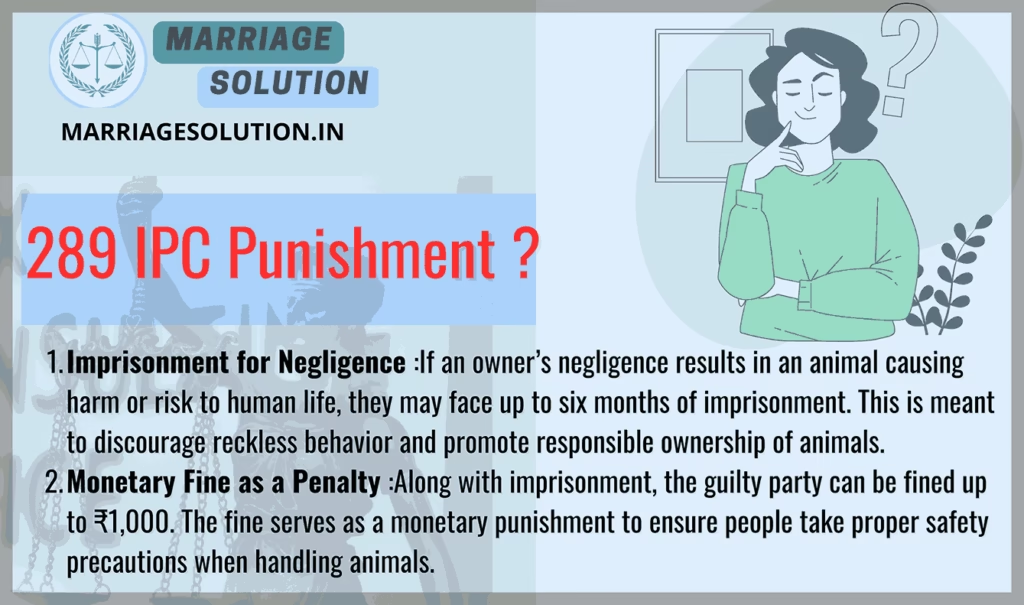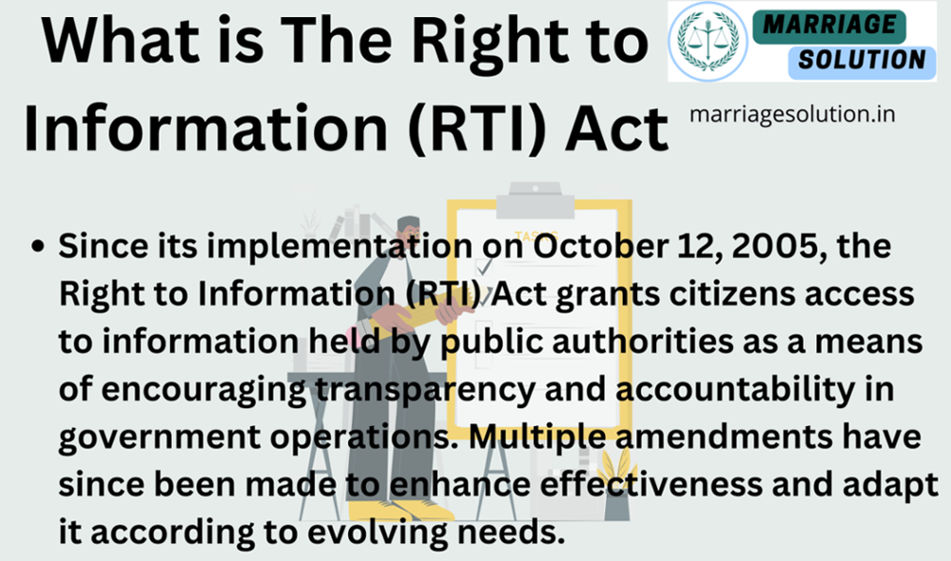Introduction of IPC 289
Section 289 of the Indian Penal Code (IPC) deals with negligent behavior towards animals that could endanger human life. This law applies when someone owns or possesses an animal but fails to take proper care in controlling it. If an animal causes harm due to the owner’s negligence, the person can face legal consequences. The punishment includes imprisonment, a fine, or both. This law helps prevent accidents, injuries, or threats to public safety caused by uncontrolled animals.
- Introduction of IPC 289
- What is IPC Section 289?
- Section 289 IPC in Simple Points
- Section 289 IPC Overview
- 10 Key Points of IPC 289
- 1. Responsibility of Animal Owners
- 2. Negligence Leading to Injury or Harm
- 3. Animals That Can Cause Danger
- 4. Failure to Secure Dangerous Animals
- 5. Precautions for Public Safety
- 6. Punishment Under IPC 289
- 7. IPC 289 as a Preventive Law
- 8. Application of IPC 289 in Urban and Rural Areas
- 9. Cases Where IPC 289 is Applicable
- 10. Importance of Awareness Among Animal Owners
- Examples of IPC 289 Violations
- Section 289 IPC case laws
- 289 IPC Punishment
- 289 IPC Bailable or non bailable
- Section 289 IPC in short information
- IPC Section 289 FAQs
- If you need support with court proceedings or any other legal matters, don’t hesitate to reach out for assistance.
What is IPC Section 289?
IPC Section 289 deals with negligent conduct towards animals, where a person fails to properly control or secure an animal in their possession. If such negligence leads to harm or danger to human life, the owner or caretaker can be punished with imprisonment, a fine, or both. This law ensures that people who own animals take responsibility to prevent accidents caused by their negligence.

Section 289 IPC in Simple Points
1. Responsibility of Animal Owners
IPC 289 places a legal duty on individuals who own or take care of animals to ensure they do not cause harm to others. If an animal is left uncontrolled, improperly secured, or negligently handled, leading to an accident or injury, the owner can be held legally responsible. This applies to both domestic and wild animals, ensuring that people take necessary safety precautions. The law encourages responsible animal ownership by making negligence a punishable offense, either through a fine, imprisonment, or both.
2. Negligence Leading to Harm
If an owner fails to properly control their animal, and it causes injury or endangers public safety, they can be punished under IPC 289. For example, if a person keeps a ferocious dog without a leash, and it attacks someone, the owner can be held guilty. Even if the injury is minor, the failure to prevent the attack is considered negligence. This law ensures that animal-related dangers are minimized in society by requiring owners to take necessary precautions.
3. Punishment for Violating IPC 289
The punishment under IPC 289 is up to six months of imprisonment, a fine of ₹1,000, or both. This ensures that people do not ignore their responsibility in handling animals. The punishment varies based on the severity of the negligence—if an animal seriously harms a person, a stricter punishment may be imposed. The court considers factors like whether the owner ignored warnings, the past behavior of the animal, and the extent of the injury caused while deciding the penalty.
4. Application to All Types of Animals
IPC 289 applies not only to pets like dogs, cats, and birds but also to livestock such as cows, buffaloes, and horses. Even wild animals kept in captivity are included under this law. If a person fails to secure an aggressive bull, and it runs into traffic, causing an accident, they can be punished under this section. This ensures that both pet owners and livestock caretakers follow safety measures to prevent harm to people and property.
5. Importance of Preventive Measures
To avoid legal consequences under IPC 289, animal owners must take preventive measures such as keeping their pets on a leash, using muzzles if necessary, building secure enclosures, and ensuring animals do not pose a threat to others. Proper training and supervision are key to preventing accidents. Authorities can issue warnings or impose penalties if an owner is found repeatedly negligent. This law helps in protecting public safety while ensuring animals are handled responsibly.
Section 289 IPC Overview
As per Section 289 of the Indian Penal Code, anyone who owns, possesses, or is in charge of an animal and negligently fails to prevent it from causing harm to another person can be punished with imprisonment of up to six months, a fine of up to ₹1,000, or both. This law applies to both domestic and wild animals, ensuring public safety.
10 Key Points of IPC 289
1. Responsibility of Animal Owners
Anyone who owns or keeps an animal must ensure its proper control. If the owner fails to take reasonable precautions, leading to the animal attacking, injuring, or threatening someone, they can be held legally accountable. This section applies to pets, livestock, or any other animals that can pose a danger to humans if not controlled properly.
2. Negligence Leading to Injury or Harm
If an owner does not secure their animal properly and it causes harm, they can be punished under IPC 289. For example, if a person leaves their aggressive dog unleashed and it bites someone, they are responsible for the injury and legal consequences. The law ensures that people do not suffer due to someone else’s carelessness in handling animals.
3. Animals That Can Cause Danger
This law applies to all animals capable of causing injury, including dogs, cattle, horses, snakes, or any wild animal kept in captivity. If an animal is known to be aggressive, dangerous, or difficult to control, its owner must take additional safety measures. Failure to do so can result in legal action if the animal harms someone.
4. Failure to Secure Dangerous Animals
An owner must take necessary steps to prevent their animal from escaping, attacking, or harming others. If a dangerous animal is left unchained, untied, or without supervision, and it injures someone, the owner is at fault. The law focuses on preventing foreseeable risks and ensuring that people handle animals responsibly.
5. Precautions for Public Safety
Animal owners are required to take proper safety measures such as building enclosures, using leashes, muzzles, or keeping animals in a secure place. If they fail to follow safety standards, they can be charged under IPC 289. The aim is to prevent harm to the public due to an owner’s negligence.
6. Punishment Under IPC 289
If an animal owner is found guilty under IPC 289, they can face imprisonment for up to six months, a fine of up to one thousand rupees, or both. The severity of the punishment depends on the level of negligence and the extent of harm caused by the animal.
7. IPC 289 as a Preventive Law
IPC 289 is not only about punishing negligence but also about encouraging responsible behavior. If people properly secure their animals and take safety precautions, they cannot be held guilty under this section. This law acts as a preventive measure to avoid accidents caused by animals.
8. Application of IPC 289 in Urban and Rural Areas
This law is applicable everywhere, including cities and villages. In urban areas, dogs, cattle, or pet animals can pose a threat, while in rural areas, livestock, bulls, and other large animals can cause injuries. The law ensures that owners are equally responsible in all locations to maintain safety.
9. Cases Where IPC 289 is Applicable
If a guard dog is left unchained and it bites a passerby, the owner can be charged under IPC 289. Similarly, if a farmer fails to control a bull, which then injures someone, the owner can be held liable. The law ensures that all types of animals are handled carefully to prevent harm to people.
10. Importance of Awareness Among Animal Owners
Many people are unaware of their responsibilities when owning an animal. They might ignore safety measures, assuming their pet or livestock will not cause harm. IPC 289 serves as a reminder for all owners to be careful and avoid negligence that could lead to accidents. It promotes safe animal handling practices for the benefit of society.
Examples of IPC 289 Violations
Example 1: A man owns a large dog known to be aggressive, but he lets it roam freely in a park. The dog bites a child, causing serious injuries. The owner can be punished under IPC 289 for negligence.
Example 2: A farmer leaves his bull untied near a busy road. The bull runs onto the road, causing an accident. Since the farmer failed to secure the animal, he can be held responsible under IPC 289.
Section 289 IPC case laws
1. Ram Kumar vs State (2021)
Case Summary: The accused left his ferocious dog unleashed in a public park, leading to the dog biting a passerby. The victim suffered serious injuries and filed a case under IPC 289.
Result: The court found the owner negligent and imposed a fine of ₹1,000 along with one month of imprisonment.
2. Mohan Lal vs State (2019)
Case Summary: A farmer failed to secure his bull properly, and it ran onto the road, causing an accident that injured a motorcyclist.
Result: The farmer was held liable under IPC 289, fined ₹500, and warned against future negligence.
3. Sunita Devi vs State (2018)
Case Summary: The accused kept a venomous snake as a pet but failed to secure it properly. The snake escaped and bit a neighbor.
Result: The accused was sentenced to three months of imprisonment and a ₹1,000 fine for negligence.
4. State vs Prakash Singh (2022)
Case Summary: A security guard left a trained attack dog unchained, which later attacked a child in an apartment complex.
Result: The court found the guard and employer guilty under IPC 289, imposing a ₹2,000 fine and a warning for strict supervision of guard dogs.
5. Ramesh Yadav vs State (2020)
Case Summary: The accused allowed his aggressive cattle to roam freely in a marketplace, leading to a woman being injured.
Result: The accused was fined ₹750 and given a two-month imprisonment sentence, emphasizing that animal owners must ensure public safety.
289 IPC Punishment
1. Imprisonment for Negligence
If an owner’s negligence results in an animal causing harm or risk to human life, they may face up to six months of imprisonment. This is meant to discourage reckless behavior and promote responsible ownership of animals.
2. Monetary Fine as a Penalty
Along with imprisonment, the guilty party can be fined up to ₹1,000. The fine serves as a monetary punishment to ensure people take proper safety precautions when handling animals.

289 IPC Bailable or non bailable
IPC 289 is a bailable offense, meaning the accused can get bail from the police or court without much difficulty. However, repeated offenses or severe negligence may lead to stricter legal action.
Section 289 IPC in short information
| IPC Section | Offense | Punishment | Bailable/Non-Bailable | Cognizable/Non-Cognizable | Trial |
|---|---|---|---|---|---|
| IPC 289 | Negligent handling of animals that may cause harm to others | Up to 6 months imprisonment, or fine up to ₹1,000, or both | Bailable | Non-Cognizable | Tried by a Magistrate |
IPC Section 289 FAQs
What is the purpose of IPC 289?
IPC 289 aims to hold animal owners responsible if their negligence causes harm to another person. It ensures public safety and prevents accidents caused by uncontrolled animals.
Is IPC 289 a bailable offense?
Yes, IPC 289 is a bailable offense, meaning the accused can get bail without strict legal conditions. However, repeated negligence may lead to stricter action.
Does IPC 289 apply to pets only?
No, IPC 289 applies to all animals, including pets, livestock, or exotic animals. Any failure to control an animal, leading to harm, can result in punishment.
Can a person be jailed under IPC 289?
Yes, under IPC 289, a person can be imprisoned for up to six months if their negligence leads to an animal harming someone. The court decides the punishment based on the severity of the negligence.
How can one avoid punishment under IPC 289?
To avoid punishment, animal owners should properly secure their animals, use leashes, enclosures, or supervision, and follow safety guidelines to prevent harm to others.
If you need support with court proceedings or any other legal matters, don’t hesitate to reach out for assistance.
Court or any other marriage-related issues, our https://marriagesolution.in/lawyer-help-1/ website may prove helpful. By completing our enquiry form and submitting it online, we can provide customized guidance to navigate through the process.
Right to Information RTI act :Your Comprehensive Guide (Part 1)
The Right to Information (RTI) Act : Explore the essence of the Right to Information (RTI) Act through this symbolic image. The image features legal documents, emphasizing the importance of transparency and accountability in governance. The scales of justice represent…
What is Article 371 of Indian Constitution ?
Article 371 of the Indian Constitution grants special provisions to specific states and regions within India, addressing their unique historical, social, and cultural circumstances. These provisions aim to accommodate diverse needs and protect cultural identities within the constitutional framework.
Indian Labour law : Your Comprehensive Guide (Part 1)
The purpose of labour laws is to safeguard employees and guarantee equitable treatment at the workplace, encompassing aspects such as remuneration, security, and perks. These regulations establish a secure ambiance by imposing minimum wage requirements, ensuring factory safety measures are…
GST :Your Comprehensive Guide (Part 1 – Understanding the Basics)
The Goods and Services Tax (GST) is like a big change in how we pay taxes in India. It started on July 1, 2017, and it’s here to simplify things. Before GST, we had many different taxes, and it could…





